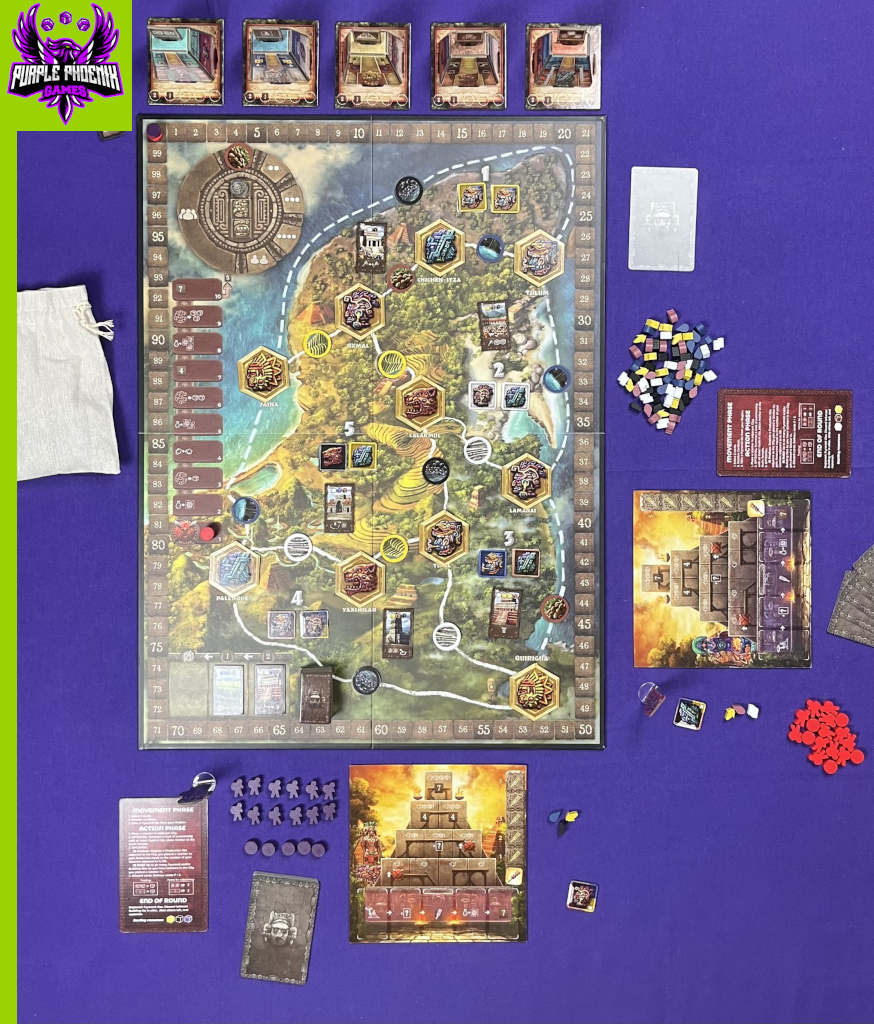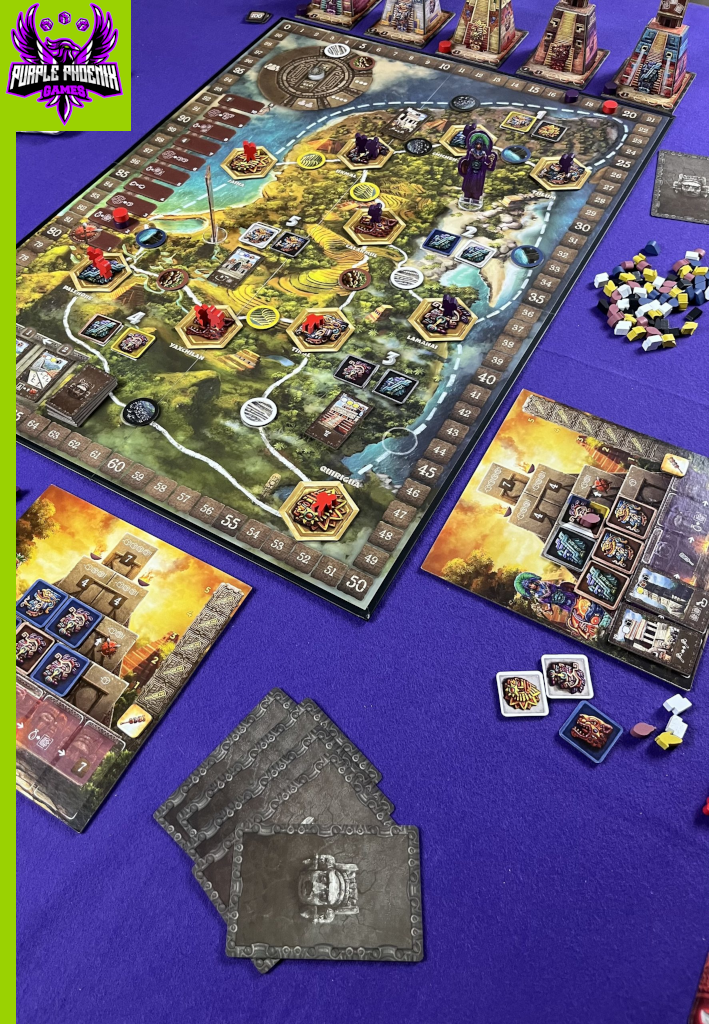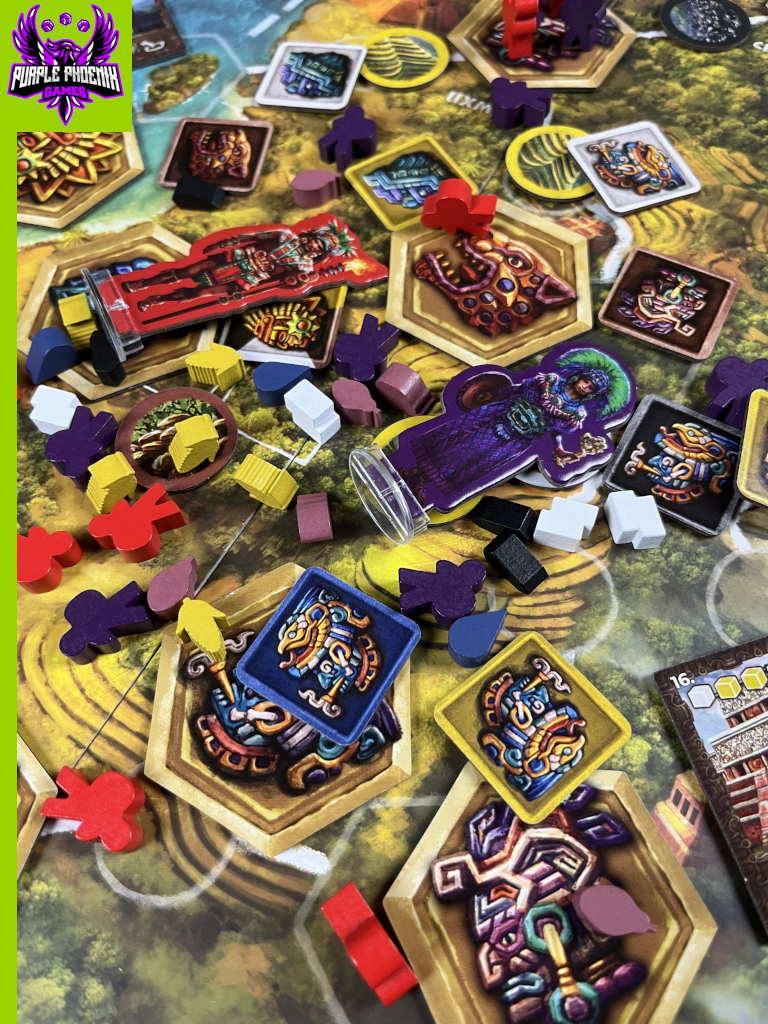
I had the opportunity this year to go to GenCon for the first time ever! It was an amazing experience, and I cannot wait to go back again next year! In my time with Purple Phoenix Games, I have made connections with several publishers, including Grand Gamers Guild. So when Marc Specter asked me to meet up at GenCon, I couldn’t say no! I got the chance to see the Grand Gamers Guild booth, chat with the people there, and sit down to dinner with Marc to talk everything games. It was awesome! And on their demo table at the con was Ahau. I already had it sitting at home for preview, but I got the chance to see it live in the wild before taking a crack at it myself. And what I saw on the demo table was intriguing and exciting. So when I got home, I started getting my plays in as soon as I could! So without further ado, read on to find out more about Ahau: Rulers of the Yucatan!
| Ahau: Rulers of the Yucatan (2023) | Grand Gamers Guild |
| 1-5 players | 90-120 minutes |
| Ages 14+ | BGG Weight – 3.47 / 5 |
Disclaimer: We were provided with a copy of Ahau for the purposes of this preview. What you see pictured below are the finalized production components. Also, I do not intend to rehash the entire rulebook in this preview (as there is a lot going on!) but rather provide a general overview of the rules and the gameplay. For a more in-depth look at the rules, pick up a copy from your FLGS or check out the digital copy on BGG. -L
Ahau: Rulers of the Yucatan (simply referred to as Ahau for the remainder of this preview) is a game of worker and tile placement in which players are trying to amass the most Fame by the end of 3 K’atun Festivals (rounds). Players will be taking turns placing workers, gathering resources, collecting Pyramid/Building tiles, building Pyramid/Building tiles, and summoning various Gods to aid in their quest for Fame and domination over the Yucatan peninsula.
To setup for a game, put out the board with the side corresponding to the player count. The board is then populated with City, Resource, Pyramid, and Building tiles as described in the rules. The 5 Temples are placed above the board, and each is randomly given a God Scoring Tile for use this game. The K’atun marker is placed on the first space of the K’atun track (to keep track of rounds). Each player then receives a player board and components in their chosen color – a Ruler, player markers, workers, and Region cards. Players receive a starting Pyramid tile for their personal supply, as well as some starting resources. Each player places 1 marker on the Fame track, and another marker on the Might track. Choose a starting player, and the game is ready to begin! Pictured below is the setup for a 2 player game.

Ahau is played over the course of 3 K’atuns (rounds), and each round is broken down into several turns. Every turn has 2 phases: Movement and Action. In the Movement phase, you choose which Region of the board to visit and perform your Actions. To start the Movement phase, all players will use their Region cards to choose which Region they want to visit, and how badly they want to go there. First choose which Region you want to visit, and place the Region card with the corresponding number face-down on the left-hand side of your player board (ex. if you want to go to Region 1, place the 1 Region card down). Next, you choose another Region card to represent your Military Strength for that Region – it is placed face-down on the right-hand side of your player board. Simultaneously, all players then reveal their Region cards. If all players chose different Regions, then great! No conflicts arise and all players place their Ruler in their chosen Region. If players have selected the same Region, then Military Strength comes into play. The player with the higher Military Strength wins and gets to visit their chosen Region, and the losing player gets kicked to an adjacent Region. Once all players have moved their Ruler to their Region for this turn, they each select an available Pyramid tile from that Region to place into their personal supply. The turn now moves to the Action phase.
The first step of the Action phase is to place a worker. Players can place a worker in any City that is adjacent to the Region their Ruler is in. Each City depicts a different God, and there are benefits to placing multiple workers in one City, as well as spreading them out amongst several Cities. After placing a worker, you have the option to summon a God – specifically the God of the City in which you placed your worker this turn. Summoning a God requires matching Pyramid tiles for that God either built into your Pyramid or personal supply, and each God provides a unique and powerful ability. Additionally, when you summon a God, place one of your markers on the appropriate God’s temple. Next, you have the option to either Produce resources or Build tiles. To Produce, choose one of the resource tiles adjacent to the City you placed your worker in this turn, and collect that type of resource. The resource tile is then moved to the Calendar track, which keeps track of when the end of the round is triggered. If you choose to Build, you can add Pyramid tiles to your pyramid or Building tiles to your player board. Pyramid tiles earn you Fame for adjacent pairs of matching icons/colors, and aid you in summoning Gods on future turns. Building tiles provide you with special abilities for use throughout the remainder of the game. The number of tiles you can build each turn is dependent on the number of workers you have in your chosen City. After completing your Actions, discard the Region cards used this turn, and prepare for the next Movement phase.
Players continue taking turns in this fashion until the Calendar track fills up, thus triggering a K’atun (end of round). During a K’atun, players will earn Fame points for each temple on which they have a marker. Each temple has a different scoring tile, and each is scored individually during a K’atun. Players also earn Fame for having the most workers in each of the 10 Cities on the board. Once the scoring in the K’atun is complete, move the K’atun marker to the next space on the track, and begin the new round with the next Movement phase. The game continues in this fashion, Movement and Action phases, until either: 3 K’atuns have been performed, a player completes their entire Pyramid, or a player has placed their final worker onto the board. Players perform one final K’atun to score their last points, and the player with the most amount of Fame is declared the winner!

So as you can probably tell from the above description, there is a lot going on in this game. It’s definitely one that you have to be totally committed to, and have to dedicate your entire brain power and attention span to. That being said, I enjoyed it. There is a big learning curve, as there are so many rules and moving pieces to keep track of. I felt like I had to reference the rulebook for pretty much every step of every turn, no matter how early or late in the game I was. There are so many little intricate details that I had to keep going back to double check everything – and that definitely added to the game time. It’s a long game anyway, but that just made it even longer. There are player reference cards and a gameplay summary on the back of the rules, but I found myself ignoring those and going to the rules themselves every time. Now that I have some more plays under my belt, I feel more comfortable. But definitely the first several plays will probably be more slow-going and tedious than is intended.
One thing I really like about Ahau is that there are many strategic options for you to take – there is no single ‘right’ way to play and win. It’s a delicate balance between building up your Pyramid and snagging powerful Building tiles, summoning the different Gods, each at just the perfect time to give you the most benefit, and gathering those precious resources. That being said, the game definitely starts out slowly and takes some time for you to build up a good engine. The first several turns will just be setting yourself up to really start the game, and that did make the gameplay feel pretty slow to me. Once I started making progress though, I felt more engaged. But be warned, at the start of the game you might not be super into it.
Another thing I really like about Ahau is that each K’atun/round may not take the same amount of time/turns to play. The K’atun is only triggered when the Calendar track fills up, and that only gets filled when players choose to take the Produce Action. So if players are focused on summoning Gods or building Pyramid/Building tiles, that particular round may be much longer than if each player decides to Produce right away. That variable length of the round is neat because it can give players time to set themselves up to score more Fame points, instead of having to scramble quickly for little payoff.
I’ll touch quickly on components. The production quality of this game is very high, and the components look great. Nice cards, sturdy cardboard chits, and neat thematic artwork. Some of the iconography could be a bit more clear as to their meanings, but it’s not totally incomprehensible. The 3D temples were kind of a pain to assemble, as some of the notches didn’t seem to line up exactly together, but once I got them done, they make the game feel fancier. Included in the game is also a booklet about the history of the peoples of the Yucatan peninsula and research about the Gods used in the game. It’s neat to see a game based on these ancient peoples was actually researched thoroughly for as much accuracy as possible. So overall, great work in the production department!
All in all, I would say that I have enjoyed playing Ahau. At first, I was feeling extremely overwhelmed, as this game is heavier than my normal fare. But as I play it more, I have become more comfortable with the gameplay. You really have to be playing the long game here, and it’s so cool to have so many different options available to you to set yourself up for success several turns/rounds in advance. If you’re looking for a game that packs in lots of mechanics and strategy, Ahau might be for you. You’ll be thinking of it even when you’re not playing, and that to me is the sign of a great game. I can’t wait to get it back on the table and see how I can work my strategy differently to see if it works better than my last plan. I definitely recommend picking up Ahau if you see it on the shelf. It’s a lot of game packing into one box, but it’s definitely worth the time and effort it takes to learn and play it!

